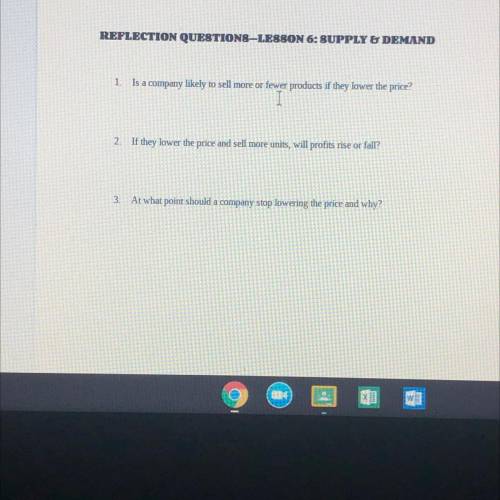
Business, 19.11.2020 18:30 charati3923
REFLECTION QUESTIONS-LESSON 6: SUPPLY & DEMAND
1. Is a company likely to sell more or fewer products if they lower the price?
2. If they lower the price and sell more units, will profits rise or fall?
3
At what point should a company stop lowering the price and why?


Answers: 2


Another question on Business

Business, 22.06.2019 02:00
On january 1, 2017, fisher corporation purchased 40 percent (90,000 shares) of the common stock of bowden, inc. for $980,000 in cash and began to use the equity method for the investment. the price paid represented a $48,000 payment in excess of the book value of fisher's share of bowden's underlying net assets. fisher was willing to make this extra payment because of a recently developed patent held by bowden with a 15-year remaining life. all other assets were considered appropriately valued on bowden's books. bowden declares and pays a $90,000 cash dividend to its stockholders each year on september 15. bowden reported net income of $400,000 in 2017 and $348,000 in 2018. each income figure was earned evenly throughout its respective year. on july 1, 2018, fisher sold 10 percent (22,500 shares) of bowden's outstanding shares for $338,000 in cash. although it sold this interest, fisher maintained the ability to significantly influence bowden's decision-making process. prepare the journal entries for fisher for the years of 2017 and 2018. (if no entry is required for a transaction/event, select "no journal entry required" in the first account field. do not round intermediate calculations. round your final answers to the nearest whole dollar.)
Answers: 3

Business, 22.06.2019 23:00
Doogan corporation makes a product with the following standard costs: standard quantity or hours standard price or rate direct materials 2.0 grams $ 7.00 per gram direct labor 1.6 hours $ 12.00 per hour variable overhead 1.6 hours $ 6.00 per hour the company produced 5,000 units in january using 10,340 grams of direct material and 2,320 direct labor-hours. during the month, the company purchased 10,910 grams of the direct material at $7.30 per gram. the actual direct labor rate was $12.85 per hour and the actual variable overhead rate was $5.80 per hour. the company applies variable overhead on the basis of direct labor-hours. the direct materials purchases variance is computed when the materials are purchased. the materials quantity variance for january is:
Answers: 1

Business, 23.06.2019 00:40
In 2017, "a public university was awarded a federal reimbursement grant" of $18 million to carry out research. of this, $12 million was intended to cover direct costs and $6 million to cover overhead. in a particular year, the university incurred $4 million in allowable direct costs and received $3.4 million from the federal government. it expected to incur the remaining costs and collect the remaining balance in 2018. for 2017 it should recognize revenues from the grant of
Answers: 3

Business, 23.06.2019 01:30
What is a market? a. a system that allows people or companies to buy and sell products and services b. the number of companies willing to manufacture a specific product c. the ability to buy production materials in large quantities and save on costs d. a product's ability to satisfy a consumer
Answers: 2
You know the right answer?
REFLECTION QUESTIONS-LESSON 6: SUPPLY & DEMAND
1. Is a company likely to sell more or fewer pro...
Questions

Mathematics, 27.09.2020 14:01

Mathematics, 27.09.2020 14:01


Physics, 27.09.2020 14:01

Mathematics, 27.09.2020 14:01



English, 27.09.2020 14:01



History, 27.09.2020 14:01

Geography, 27.09.2020 14:01


Biology, 27.09.2020 14:01



Mathematics, 27.09.2020 14:01


Chemistry, 27.09.2020 14:01

Mathematics, 27.09.2020 14:01



